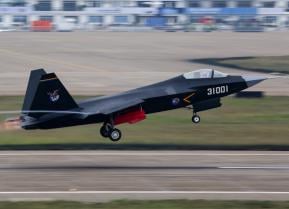This Country Wants the F-35 (And China Won't Like It)
Singapore’s Ministry of Defense recently announced that the F-35 is the best candidate to replace the island-nation’s 60 aging F-16 fighters.
Singapore’s next fighter jet may be the F-35 – and China won’t like that.
Singapore’s Ministry of Defense recently announced that the F-35 is the best candidate to replace the island-nation’s 60 aging F-16 fighters.
“The Republic of Singapore Air Force (RSAF) and Defense Science and Technology Agency (DSTA) have completed their technical evaluation to select the next generation fighter to replace its F-16s,” according to the brief announcement. “The F-16s will have to retire soon after 2030 and the F-35 Joint Strike Fighter (JSF) has been identified as the most suitable replacement to maintain the RSAF's capabilities.”
But note that the Ministry of Defense added an important caveat. “The technical evaluation also concluded that the RSAF should first purchase a small number of F-35 JSFs for a full evaluation of their capabilities and suitability before deciding on a full fleet. In the next phase, MINDEF [Ministry of Defense] will discuss details with relevant parties in the US before confirming its decision to acquire the F-35 JSFs for Singapore's defense capabilities.”
In other words, Singapore -- known for its prudent if somewhat authoritarian government -- wants to thoroughly inspect the goods before it buys. Given the F-35’s checkered development history, and the long list of bugs that need to be fixed, it’s a sensible approach.
Two questions surround the possible F-35 purchase, according to commentator David Boey, writing in Singapore’s Today news site. First, will the F-35 be the final choice of a fighter search that has been ongoing since 2004? “Fans of the F-35 were disappointed the fighter jet was not declared a clear winner but nonetheless relieved that it is still in the running,” Boey wrote. “Opponents were disappointed the aircraft was not dropped outright after such a lengthy assessment but nonetheless relieved that only a handful — possibly as few as two aircraft — will be used for a thorough assessment.”
F-35 manufacturer Lockheed Martin will have to demonstrate that the Lightning II can operate in Singapore’s tropical climate. Boey points to the 2010 crash of an RSAF AH-64 Apache helicopter. “The investigation found that corrosion of an engine part sooner than maintenance cycles could detect the degradation contributed to the crash,” Boey notes. “The component failed as a result of operating in Singapore's airspace, which has high salinity as sea breezes constantly fan across the island.”
Another obstacle could be how much Lockheed Martin will allow Singapore to modify the F-35. “Past hang-ups over access to source codes that control sensitive electronic warfare equipment have seen Singapore turn to alternative vendors to fulfil the RSAF's operational requirements,” writes Boey.
The second question is what fighter Singapore would buy if the F-35 falls through. Boey suggests other contenders would include the F-15, Eurofighter Typhoon and France’s Rafale. These also happen to be the same aircraft that Canada is considering as it contemplates replacing its fleet of CF-18s, the Canadian version of the F/A-18 Super Hornet. Singapore already operates 40 F-15SGs, the local variant of the F-15E Strike Eagle.
Ultimately, the elephant in the Southeast Asian jungle is China, whose claims over the waters and islands of the South China Sea have alarmed its neighbors. This includes Singapore, the gate to the one of the world’s busiest shipping lanes. Possession of a cutting-edge stealth fighter would enhance Singapore’s power, though it’s unclear how may Singapore would buy (at about a hundred million dollars an aircraft, replacing all 60 F-16s with F-35s would be an expensive proposition).
Michael Peck is a contributing writer for the National Interest. He can be found on Twitter and Facebook.
Image: Lockheed Martin.


